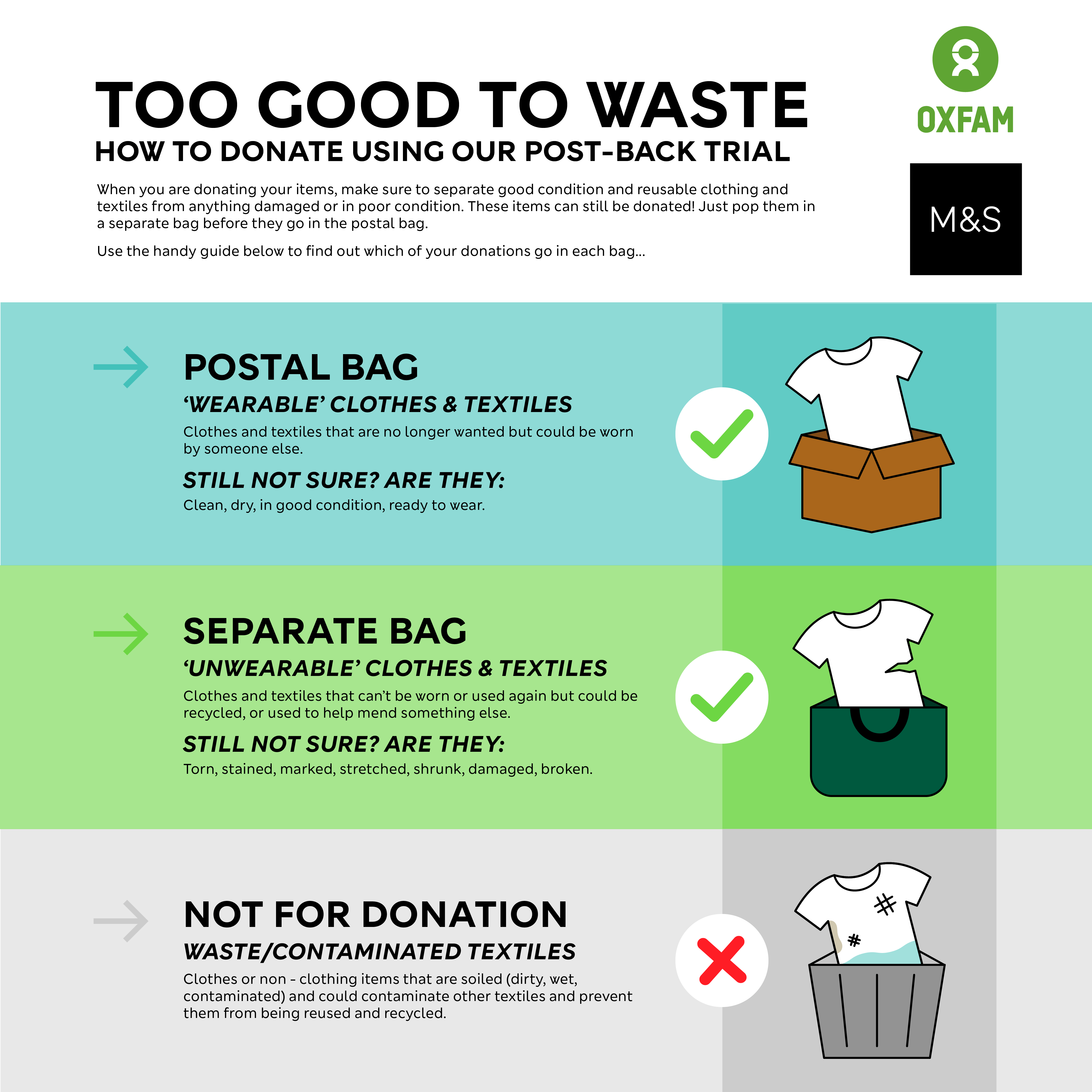
- One third of the UK does not know what to do with pre-loved clothing which is unwearable according to new research.
- WRAP, the climate action NGO, define wearable clothing as clean, dry, in good condition and ready to be worn by someone else. While unwearable clothing is damaged in some way – for instance torn, stained, faded, or stretched.
- New M&S and Oxfam trial allows consumers to donate unwearable but too-good-too waste clothing, alongside their preloved wearable clothing, via a simple online postal donation service.
- Trial is funded by the M&S Plan A Accelerator Fund which commits £1m to innovative projects to help achieve net zero goals.
Marks & Spencer is, for the first time, asking the public to donate their unwearable clothing, alongside their wearable clothing, through the trial of a free postal donation service, in partnership with Oxfam.
It is estimated that UK homes contain 1.6 billion items of unworn clothing which have the potential to be used, re-used or recycled*. However new research conducted on behalf of M&S**, found that one third of the UK doesn’t know what to do with clothes that cannot be re-worn – with three in 10 consumers admitting to disposing of unwearable clothes in their household waste bin.
To help tackle the problem, from today, consumers will be able to recycle their preloved clothing from the comfort of their own home by ordering a pre-paid postal donation bag from the Oxfam website. The bag, which is made from 100 percent recycled plastic, allows for preloved clothing to be separated into two groups – those that are good quality and wearable and those that are unwearable – but equally too good to waste – and return them for free via a local courier where they will then go directly to Oxfam to be resold, reused, or recycled.
Closet confusion
New research conducted for M&S found that one in five consumers admit they are confused by what is meant by ‘wearable’ and ‘unwearable’ clothing. WRAP, the climate action NGO, define wearable clothing as clean, dry, in good condition and ready to be worn by someone else. While unwearable clothing is damaged in some way – for instance torn, stained, faded, or stretched. Clothes which are soiled or contaminated are not recyclable and customers are asked not to include these items. To help consumers navigate what preloved clothing can be donated, M&S has worked with Oxfam to create a simple ‘how-to’ guide, which will be enclosed in the pre-paid donation bag.
M&S has been leading the way with new and exciting products and services since its inception 140 years ago and continues to innovate while never compromising on quality or sourcing and production standards. Through the trial, which is funded through M&S’ Plan A Accelerator Fund, M&S wants to find new ways to reduce textile waste and increase the use of recycled fibres to drive the circular economy – a key part of the retailer’s Plan A sustainability plan.
Katharine Beacham, Head of Materials, Sustainability and Packaging at M&S, commented: “At M&S, we’re focused on making good quality, durable products which are made to last. In 2008, we launched Shwopping to support customers to give a second home to their preloved clothing, and we’re now expanding our partnership with Oxfam to trial a free postal service which enables customers to clear out their pre-loved clothing that they no longer need. Whether it is wearable or unwearable – we want it all!”
Lorna Fallon, Trading Director at Oxfam, commented: “We are so excited to be working with M&S as part of this brand-new trial. As well as continuing to encourage customers to donate their preloved, wearable clothing to Oxfam and help raise vital funds to tackle poverty around the world, this trial allows us to give unwearable clothes a second chance of life too. By recirculating our clothes, buying, and wearing second hand, we can help to reduce the demand for new clothes, which could in turn help to reduce the damage to our planet. So, by learning more about the potential of all our clothes and textiles, we can help improve the lifecycle of all of our clothing for the better.”
The trial forms part of the ‘ACT Project’ which is being led by the UK Fashion and Textile Association (UKFT). The UKFT is working to develop a new framework towards a UK-based automated-sorting and pre-processing facility (ATSP) that will recycle clothing unsuitable for re-sale to make new clothing which can be sold in the UK to create a completely circular system.
Adam Mansell, CEO at UKFT, commented: “We’re delighted to be working with Marks & Spencer and Oxfam to give old clothing a second chance at life. We need to ACT now to tackle the staggering amount of textile waste that ends up in landfill or incinerated each year. Through this trial, we’re aiming to encourage people to separate their items so that in future, worn-out clothing can make its way to an automated sorting facility and then be recycled into new textiles and garments here in the UK.”
Consumers can use the service to donate any item of preloved clothing from any retailer, as well as soft furnishings textile waste such as bed linen, towels, cushions, tablecloths, and tea towels. M&S’ in-store Shwopping scheme continues to be for wearable, hand-me-down quality clothing only.
Those interested in using the service can order their pre-paid postal donation bag and find out more about the ACT textile waste trial in partnership with Oxfam here.
*WRAP, Citizen Insights: Estimating the Longevity of Home Textiles in the UK (2022).
**1,036 consumers were polled, nationally representative sample of the UK, using the Toluna panel between 23 and 27 Feb 2024.







